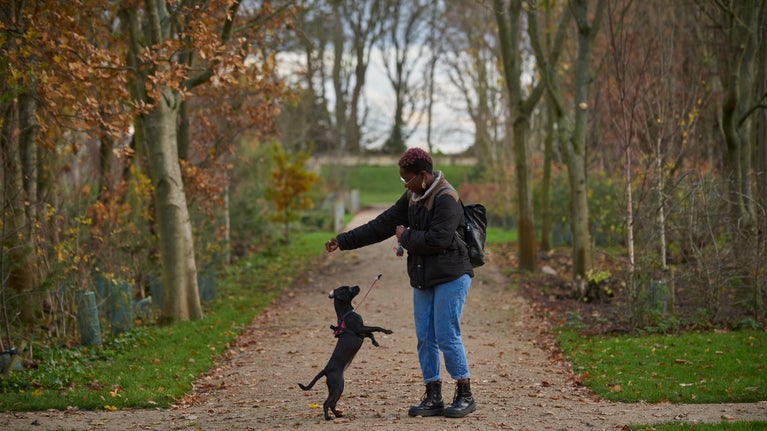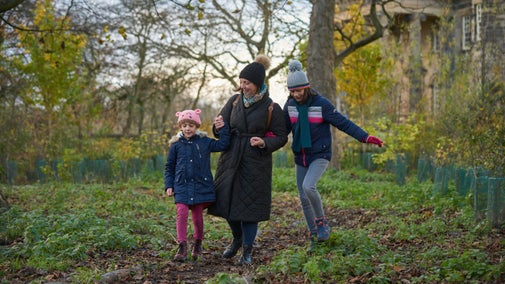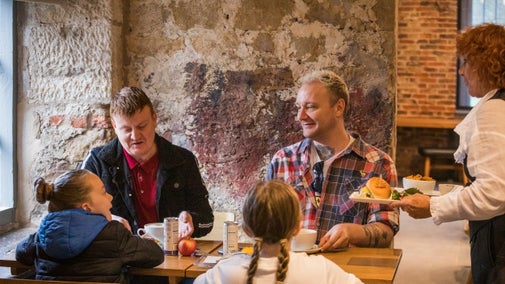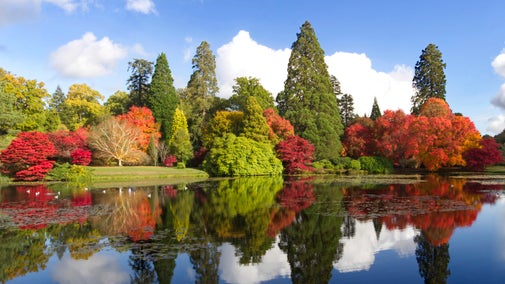
Discover more at Seaton Delaval Hall
Find out when Seaton Delaval is open, how to get here, the things to see and do and more.

Discover the gardens at Seaton Delaval Hall. Explore the formal garden with its manicured lawns and topiary, stroll through the relaxed, wildflower-laden woodlands and uncover your playful side in the South East Garden. Enjoy family activities and stretch your legs on one of the walks across the wider estate.
At this time of year, the herbaceous growth is cut back and the trees are bare. You’ll see how this highlights the formal lines of the hedges and the geometry of the Parterre. This is also the best time of the year to catch glimpses of the Mausoleum from the South East Gardens, through the trees along the Sea Walk Walls.
The great weeping ash seems to come alive now as its long, bare branches clack together in the wind. By February, snowdrops carpet the woods and ice house and bright yellow aconites peep out from the borders.
Designed by Sir John Vanbrugh, the landscape provides the same sense of drama and theatre as the Hall itself, and was a playground for the whole Delaval family.
Smaller spaces near the hall such as the Secret Garden and Privvy Garden provide shaded spots to rest and recharge with deckchairs and picnic spots available. On clear days enjoy the sweeping views north towards the Cheviot Hills. Look out for classic Vanbrugh design features around the Hall such as the obelisk, which draws your eyes out to the far southern landscape.

Discover the beautiful structure of the Parterre at any time of year, with its formal hedges, whitebeam ‘lollipop’ trees, fountain, urns and standard bay trees. And depending on the season you’ll be treated to bursts of colour from tulips, azaleas, lavender, geraniums and fuchsias.
Formerly a tennis court, it was created between 1950 and 1953 and was the first large-scale commission for garden designer James Russell, whose brief was to ‘Italianise’ the garden and who later became head gardener at Castle Howard.
See the magnificent weeping ash tree, set in its own lawn and surrounded by herbaceous borders. We believe it was planted around the same time as the Hall was built. Sadly it lost a limb during Storm Arwen in 2021, but it still sits with pride of place in the formal gardens.
Breathe in the aroma of the formal Rose Garden, which is in full bloom from mid-spring to late autumn. Each variety was chosen for its beautiful foliage and fragrant scent. Look out for the dark pink flowers of ‘Gertrude Jekyll’ and the coppery orange and yellow of ‘Just Joey’ and ‘Graham Thomas’.
The herbaceous borders to the north of the Rose Garden come alive in early spring. They offer an ever-changing delight, from subtle yellow and pink flowers in spring to a vivid explosion of colour in summer lasting into autumn.
Pull up a deckchair and relax in this peaceful spot, which was originally a private garden for Lady Hastings. Enclosed by yew hedging and unusual Ghent hybrid azaleas, there’s a small pond and the summer house where you can buy ice creams and light refreshments in summer.
The arboretum is planted with various trees and rhododendron bushes and it’s one of the most popular picnic spots in the garden. From here you can visit the Church of Our Lady but this isn’t managed by the National Trust, so be sure to check the opening times directly with the church before visiting.

Explore the recently transformed South East Garden, a thriving space where plants, trees and wildlife have the space to grow and flourish. Soak up the views across the wider landscape from here – we’ve reinstated the paths and sightlines using Vanbrugh’s 1781 estate plan as inspiration.
We’ve also reintroduced Lady Tyrconnel’s wildflower garden with a Tibetan cherry tree as its centrepiece. And don’t miss The Oval, once the location for many a ‘gay Delaval’ party. It’s now the perfect place for a quiet picnic or a spot of cloud gazing.
Look out for two installations designed by Studio Hardie in the South East Garden. The Mirror Cube and Dark Matter Cube capture the playful spirit of the Delavals. They were inspired by the way the garden was originally designed to conceal and reveal different views and features.
Stop by the Community Kitchen Garden and chat to the National Trust volunteers about what they're growing. Keep your eyes peeled for some unusual fruits and vegetables in the raised beds.
There’s also the Cutting Garden, where the Hall’s flower arrangements are created, a wildlife area and a herb garden.


Find out when Seaton Delaval is open, how to get here, the things to see and do and more.

There's lots to enjoy as a family at Seaton Delaval Hall. Whether you're uncovering the stories of the flamboyant Delavals through the collection and creative installations or you're enjoying the take on their love of trickery and theatricality in the gardens or enjoying the Delaval Playdium, there's something for all families to enjoy and discover here. Enjoy festive, Christmastime family fun here in Northumberland.

Seaton Delaval Hall is a two pawprint rated place. There’s plenty of ground for dogs to roam at Seaton Delaval Hall. Find out where you can walk your dog on the estate and the facilities available for your four-legged friends.

Uncover centuries of history and the story of the flamboyant and theatrical 'gay Delavals' in architect Sir John Vanbrugh's stunning buildings at Seaton Delaval Hall. Discover the dramatic scars of the fierce fires that nearly condemned it to ruin 200 years ago and see how the creativity and mischief has returned to this country house once more.

Learn the story of this baroque Northumberland manor house and the individuals who shaped it, including architect Sir John Vanbrugh and the notorious 18th-century Delaval family.

During your visit to Seaton Delaval Hall, stop by the Brewhouse Café. Housed in a 17th-century building, it offers a wide range of drinks and snacks, as well as indoor and outdoor seating.

Find out more about the main restoration projects from the first 10 years at Seaton Delaval Hall, from restoring the weather-damaged marble floor to adding a brand new cornerstone.

From 18th-century water gardens and Arts and Crafts landscapes to intimate woodland gardens, there are so many places to discover.

Discover our gardeners’ top tips so you can make the most of your garden, plot or window box.